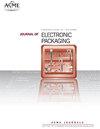Process Recipe and Functional Circuitry Performance On Aerosol Jet Printed Water-Based Silver Ink
IF 2.2
4区 工程技术
Q3 ENGINEERING, ELECTRICAL & ELECTRONIC
引用次数: 0
Abstract
The demand for compact, lightweight, and stretchable printed electric circuits has increased with the advancement of flexible printing technology in electronics. The viability of environmentally friendly water-based inks with low-impact waste requires the development of process recipes for component attachment on flexible substrates. The focus of this paper is on demonstrating a comprehensive study of process parameters and component attachment on the aerosol jet printer (AJP) platform, utilizing water-based silver nanoparticle ink. The investigation covers printing parameters, including UAMFC, SMFC, stage speed, multiple passes, and sintering analysis (time and temperature). Evaluation of print quality is conducted using white light interferometry (WLI) and optical microscopy images. The cross-sectional area (CSA) of printed lines is computed by integrating the bell-shaped CSA obtained from the WLI test. Electrical and mechanical properties are quantified in terms of resistivity and shear load to failure. Optimized parameters from the printing and sintering process are employed to print traces, and various components are attached using Electrically Conductive Adhesive (ECA). The impact of sustainable ink and ECA on passive components is analyzed by comparing their performance before and after attachment. Components within an acceptable range of the rated value are in proper functioning order, contributing to the advancement of flexible and sustainable electronics. Finally, a practical differentiator circuit has been used to demonstrate the functionally working circuitry and compared the output with the simulated one.气溶胶喷印水性银墨的工艺配方和功能电路性能
随着柔性印刷技术在电子领域的发展,人们对结构紧凑、重量轻、可拉伸的印刷电路板的需求越来越大。要实现环保型水基油墨的可行性和低废料影响,就必须开发出在柔性基底上附着元件的工艺配方。本文的重点是利用水基银纳米粒子油墨,对气溶胶喷射打印机(AJP)平台上的工艺参数和元件附着进行全面研究。研究涵盖了打印参数,包括 UAMFC、SMFC、阶段速度、多次通过和烧结分析(时间和温度)。使用白光干涉仪(WLI)和光学显微镜图像对印刷质量进行了评估。印刷线的横截面积(CSA)是通过对白光干涉仪测试得到的钟形 CSA 进行积分计算得出的。电气和机械性能通过电阻率和失效剪切载荷进行量化。采用印刷和烧结过程中的优化参数来印刷迹线,并使用导电胶(ECA)粘贴各种元件。通过比较附着前后的性能,分析了可持续油墨和 ECA 对无源元件的影响。在额定值的可接受范围内,元件都能正常工作,为柔性和可持续电子产品的发展做出了贡献。最后,使用了一个实际的差分电路来演示电路的工作功能,并将输出与模拟输出进行了比较。
本文章由计算机程序翻译,如有差异,请以英文原文为准。
求助全文
约1分钟内获得全文
求助全文
来源期刊

Journal of Electronic Packaging
工程技术-工程:电子与电气
CiteScore
4.90
自引率
6.20%
发文量
44
审稿时长
3 months
期刊介绍:
The Journal of Electronic Packaging publishes papers that use experimental and theoretical (analytical and computer-aided) methods, approaches, and techniques to address and solve various mechanical, materials, and reliability problems encountered in the analysis, design, manufacturing, testing, and operation of electronic and photonics components, devices, and systems.
Scope: Microsystems packaging; Systems integration; Flexible electronics; Materials with nano structures and in general small scale systems.
 求助内容:
求助内容: 应助结果提醒方式:
应助结果提醒方式:


